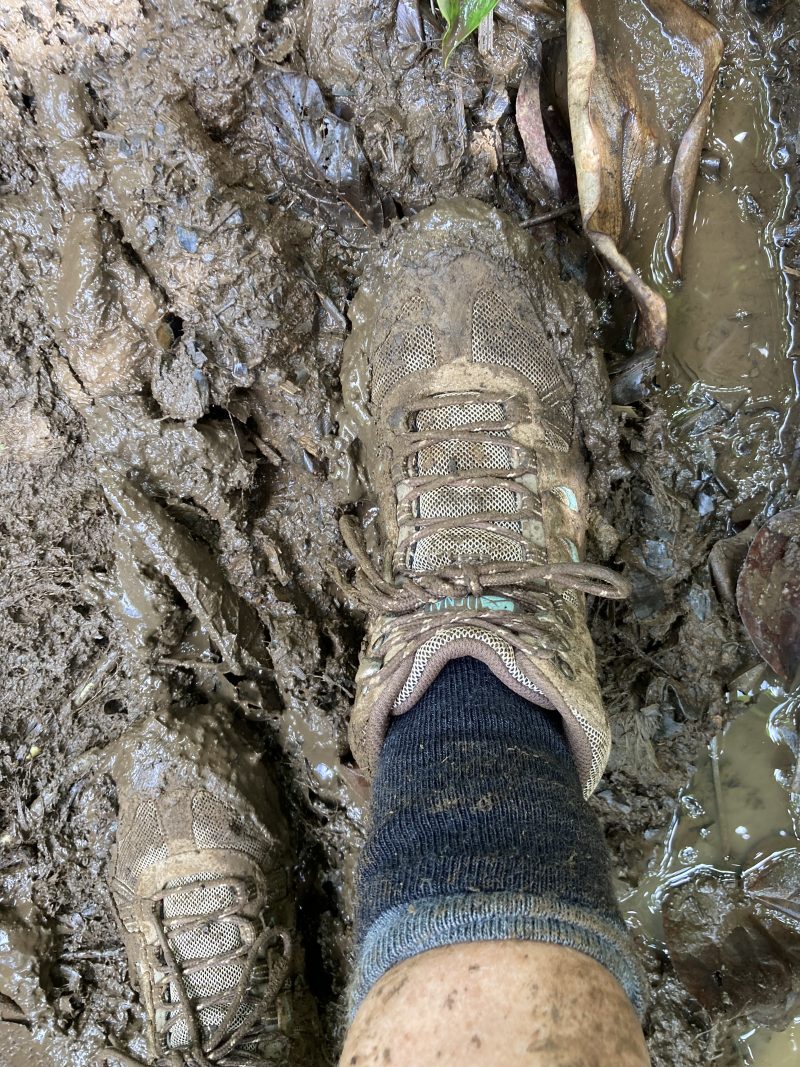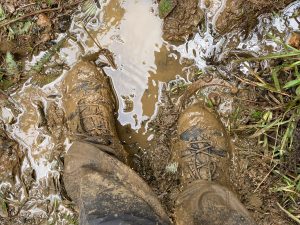I hate . . . cleaning my boots!

I really don’t look forward to cleaning my boots after every hike and/or plant restoration work party. It’s such a hassle to do this after each time on the trail and sometimes I go out 6-7 times a week!
But after every hike I do the following:
- Brush/scrape my boots with a stiff bristle brush, a fork or knife to get dirt out of cracks.
- Wash the outside of my boots with a high pressure hose if outside or with the kitchen faucet or bucket if inside. Typically I have to brush the boot as I am running the water from an outside hose or kitchen faucet. Sometimes I find it helps to soak the bottom of my boots in water first. I try to avoid getting water into the boot. Some recommend using specialized boot cleaning soaps or mild solution of soap and water. Just make sure the cleaner is safe for your type of boot.
- Spray my boots with isopropyl rubbing alcohol – 70%.
- Drying the boot. If the inside of the boot is wet I take out the insole and stuff the boot with newspaper. I may remove the soaked newspaper and restuff a few times. I then put my boots outside in a protected area to dry.
Thank you if you are already religiously taking the above steps.
As hikers, we are helping spread invasive plants further into our pristine native ecosystems. Yes, the spread is also done by wind, birds, and ungulates (like pigs), but I can do my part by minimizing the spread through my boots. Every new invasive is impacting a native plant and our watershed.
Here are some reasons why the above steps are so important.
1. Help save endangered plants from extinction.
I am sure you are aware that Hawaii is considered the “Endangered Species Capital of the World.” We already have over 100 extinct (lost forever) plants and currently 366 of the Hawaiian plants are listed as Endangered or Threatened by Federal and State governments, and many more are likely to join the list soon. We are losing many of our unique plants. Part of the threat is that non-native plants are dramatically spreading into the native forests. Not every non-native plant is invasive. They are called “invasive” when it becomes clear that they are causing harm to the environment.
- Non-native plants compete for water.
- Non-native plants tend to reproduce and grow faster than native plants, thus shading native plants from the sun.
- Some non-native plants also change the soil and make it toxic for other plants to survive. (Notice how nothing else thrives in the bamboo forests.)
2. Help save our watershed and future drinking water
Unfortunately, invasive plants also impact the land’s ability to capture water and are increasing erosion. Our native forests, over millions of years, developed an ecosystem that maximized the ability for rain to be captured, enter the watershed, and provide our drinking water. This has been dramatically disturbed by invasive plants. Strawberry guava is one tree that consumes 53% more water than the native Ohi’a tree. A native plant ecosystem prevents erosion by absorbing water into the ground, resulting in less water and soil runoff going down the streams, eventually impacting coral reefs and marine life. Unfortunately, the shallow root systems of many invasive plants can cause soil instability and landslides.
Here’s a great link with more details
https://storymaps.arcgis.com/stories/c42c0cdd5ace4044ba679d6a74e8f6be
3. Fungus is killing our beloved Ohi’a
Ohi’a trees are key to the survival of the Hawaiian forest ecosystem and they are dying from Rapid Ohi’a Death (ROD) due to the spread of a fungal disease. The problem started on the Big Island and it now has spread to Maui, Kauai, and O’ahu.
The fungus, spreads mainly by wind, gets into broken branches or wounds in the trees, but hikers can also spread the fungus. The fungus could be on our boots, and we could be spreading it into pristine Ohi’a forests.
All it takes to kill the fungus: Spray your boots with isopropyl rubbing alcohol – 70%. You can also use a mix with a 10% bleach solution. If you are hiking into a pristine Ohi’a area, you might bring a small spray bottle and spray your boots before entering.
So…. Just like I don’t really enjoy brushing my teeth twice a day… I do it to save the future of my teeth. And I clean and spray my boots after every hike. I hope you will join me in doing this one small thing to protect our ecosystem and watershed for future generations.


